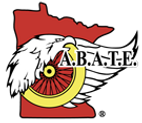top of page

LEGISLATION
Understanding Minnesota Legislaton
Understanding Minnesota Legislation
DON'T JUST SIT THERE! FIND OUT HOW YOUR MINNESOTA STATE LEGISLATURE WORKS TODAY!
FIND OUT WHO SUPPORTED WHICH BILLS AND FIND BILLS YOU WOULD LIKE TO SUPPORT!
REGISTER TO VOTE IN MINNESOTA!
For more information on legislation, please reach out to the A.B.A.T.E. of MN legislative team
Minnesota Laws and Regulations
Write to Ride
The goal of the Write to Ride program is to encourage communication between A.B.A.T.E. members and legislators at the state and federal levels.
Establish initial communication with a legislator (State or Federal). The communication does not need to be motorcycling specific but can be related to any issue of legislative concern.
Send your letter and response from your legislator to receive your 'Write to Ride' patch. Each year of correspondence with legislators you will receive a rocker. Forward a copy with your A.B.A.T.E. member's and Chapter name to A.B.A.T.E. Write to Ride.
SEND REQUESTS TO:
Frank Ernst
840 Cree Drive
Chanhassen, MN 55317
or Email: Write2Ride@abatemn.org

bottom of page
